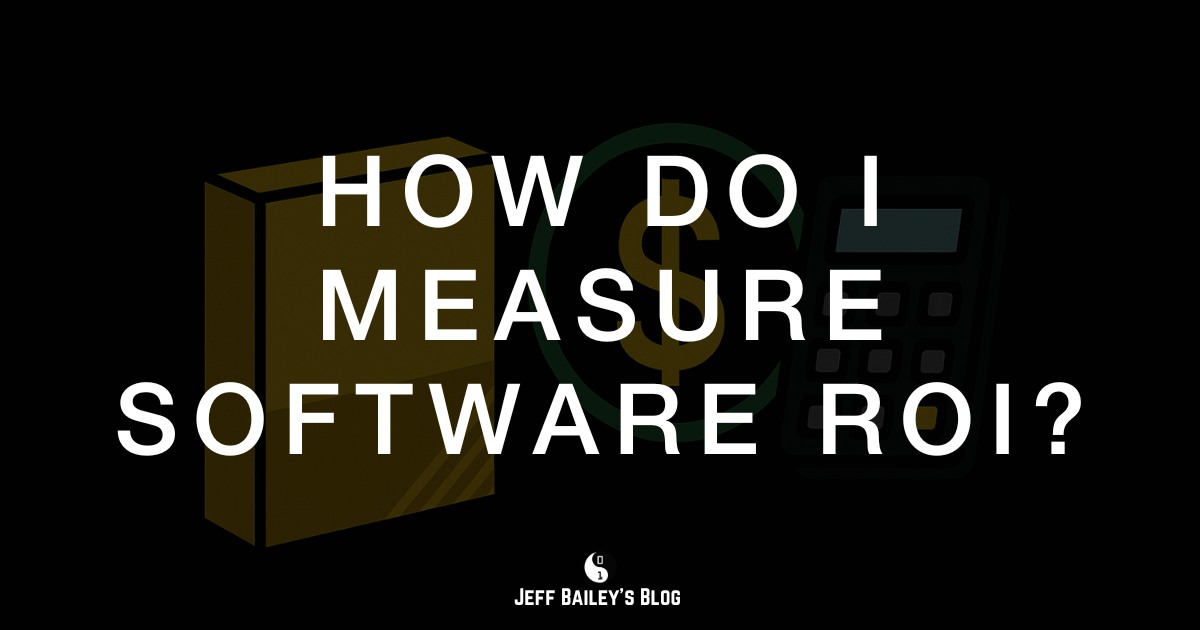I’ve been in your shoes. As a software leader, I’ve had to justify development costs. As a buyer, I’ve done countless cost/benefit analyses. And yes, as a developer, I’ve spent money on software that never got used. 💸
Let me walk you through a simple way to measure software Return on Investment (ROI). No finance degree or Master’s in Business Administration (MBA) required—just common sense and a few basic formulas.
TL;DR;
If you’d like to skip most of my post, here’s the bottom line:
Add up all costs (license, hosting, labor, hardware). Compare to revenue. If costs far exceed revenue and it’s not growing, optimize your backlog for cost savings.
$$ \text{Cost} = \text{License} + \text{Hosting} + \text{Labor} + \text{Hardware} \ \text{Action} = \begin{cases} \text{Optimize for cost savings} & \text{if } \text{Cost} \gg \text{Revenue} \ \text{Continue with planned work} & \text{otherwise, prioritize from the backlog} \end{cases} $$
The ROI Formula
Here’s a simple formula to calculate ROI:
$$ ROI = \frac{Net\ Profit}{Cost\ of\ Investment} $$
- Net Profit: What you make from the software
- Cost of Investment: What you spend to get and run it (including labor)
If profit > cost, you’ve got a positive ROI. If cost > profit, well… fire up the backlog.
Calculating Net Profit
Here’s how to calculate net profit:
$$ Net\ Profit = Revenue - Cost\ of\ Investment $$
The math is straightforward, but finding the revenue can be tricky. For more on managing software costs effectively, check out our guide on software delivery.
I’ll explain each part of the formula.
How to Calculate Investment Costs
The cost of investment includes everything you need to get the software running:
$$ Cost\ of\ Investment = License\ Cost + Hosting\ Cost + Hardware\ Cost + Labor\ Cost $$
Here are the key questions to ask:
- What’s the license or subscription cost?
- How much for hosting?
- Do I need any special hardware? (less common, but some hardware comes with a software subscription)
- What’s the labor cost for implementation and maintenance?
Revenue Sources
Software can generate revenue in two ways:
Direct Revenue
- Software sales
- Subscriptions
- Usage fees
- Support contracts
Indirect Revenue
- Time saved × hourly rate
- Lower operational costs
- New business opportunities
- Better customer retention
Real-World Example
Let me walk you through a practical example:
Scenario: Implementing a CRM system
Cost of Investment:
- License: $50/user/month × 10 users = $500/month
- Hosting: $200/month
- Hardware: $0 (cloud-based)
- Labor: $100/hour × 40 hours implementation + $20/hour × 10 hours/month maintenance = $4,200 initial + $200/month Total Initial: $4,900 Total Monthly: $900/month
Revenue Calculation:
- Time saved: 5 hours/week per rep
- Hourly rate: $50
- Team size: 10 reps
- Monthly savings: 5 hours × 4 weeks × 10 reps = 200 hours
- Value: 200 hours × $50 = $10,000
ROI Calculation:
- Monthly Net Profit = $10,000 - $900 = $9,100
- ROI = $9,100/$900 = 10.11 or 1,011%
Note: This ROI calculation assumes the initial implementation cost is amortized over the first year. For a more accurate long-term ROI, you’d want to calculate this over multiple years.
Common Pitfalls
Here’s what I’ve learned to watch out for:
Overestimating Benefits
- Don’t assume 100% adoption
- Factor in learning curves
- Account for maintenance time
Underestimating Costs
- Training expenses
- Integration work
- Ongoing maintenance
- Support needs
Missing Intangible Benefits
- Customer satisfaction
- Data quality
- Better decisions
- Market advantage
Best Practices
Here’s what I’ve found works best:
Set Clear Metrics
- Define success
- Measure baseline
- Review regularly
Track Progress
- Monitor usage
- Get user feedback
- Measure actual savings
- Compare to projections
Stay Flexible
- Update calculations
- Revise assumptions
- Adapt to changes
Conclusion
Want to know the best part? Measuring software ROI doesn’t have to be complicated.
Just remember to:
- Be realistic about costs and benefits
- Consider both direct and indirect impacts
- Track and adjust over time
- Focus on business outcomes
For more on software development best practices, check out my guide on software architecture.

Comments #